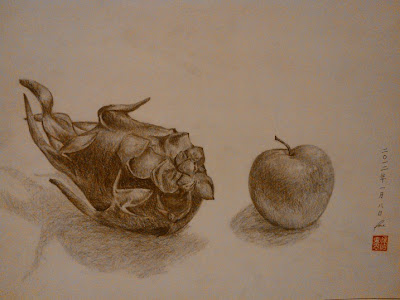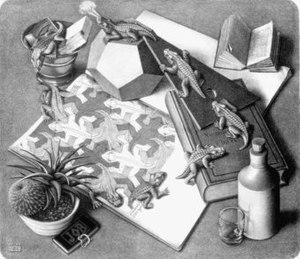
Artist Lucia Hartini
Title: Spying Lens, 1989
Type: Oil painting
Dimensions: 394 cm x 422 cm
This is a
Surrealist painting, which involves dreams and fantasies, basically anything
out of the norm portrayed realistically.
In the
foreground lies a woman all hunched up in a foetal position, coiled in drapery
dyed ultramarine, the colour that represents the female warriors in her
country. This cool colour clearly contrasts with the headstrong brick red, the
colour of the zig-zag walls confining her. This is a jarring sight as the two
colours juxtapose and contradict each other as they belong to two different
polarities. Skilful in a sense, partnering these two colours result in visual
discomfort for some, successfully evoking disturbed feelings from those who
view the painting. The lady appears to be levitating, ‘safe’ from the shattered
ground, but at the same time, in a precarious position as nothing is supporting
her, engaging viewers in a tirade of emotions: wonder how she floats without
support, fear for her because she has no support and pity, should she fall or
perhaps she has to remain in this position forever…
Moving to the
midground as our eyes follow the reverberating wall, there are three eyes
lurking behind the lady, trained on her in fact, scrutinising her every
movement, just like how Lucia was closely examined in her hometown just because
she was a minority. The ultramarine drapery is still visible, floating
magnificently in the midground, symbolic of the fighting spirit that the female
warriors in her hometown embody, protecting the lady, whom I guess is Lucia
herself.
Finally, the background,
which does not seem to mark the boundary of the painting as the zig-zag walls
continue to stretch further, into the vanishing point, effectively increasing
the depth of this painting. There seems to be billowing smoke coming out of the
insides of the walls and as the smoke escapes, it brings forth an ominous
feeling that reminds me of thunderclouds. Well matched by the reverberating
walls that look like a lightning streak, this painting gives a foreboding omen
that marks the beginning of the apocalypse. The smoke spreads to the sides of
the background, affecting the rest of the sky with its sinister and omnipresent
aura. Darkness prevails.
However,
not all hopes are lost as there is still light illuminating the foreground,
effectively bringing the focus to the lady in blue. Lucia painted her using
fine brushstrokes that define every detail ranging from her facial features to
the bricks, very much like the Surrealist style, which emphasises photorealism.
A typical characteristic of Surrealism is that it involves a great deal of
symbolism, which Lucia has utilised fully in her painting.

Artist Lucia Hartini
Title: Spying Lens, 1989
Type: Oil painting
Dimensions: 394 cm x 422 cm

Artist: Frida Kahlo
Title: Memory, 1937
Type: Oil Painting on metal
Dimensions: 40 cm x 28.3 cm
In
Memory, Frida portrayed herself in a European dress, instead of a Tehuana dress, which her husband Diego adored, which is thus somewhat unusual from her other self portraits that pictured herself in traditional decorative Tehuana dresses. It could be due to the fact that she was divorced with her beloved Diego due to his adultery, which inflicted much pain on her mentally. This could possibly have led her to depict a hole in her left side of her chest, a void, that once held her heart, the heart that had previously contained her love for Diego, was now missing. However, her heart is not completely gone as next to her right foot lies an enormous heart, bloody and alive, and seems to be palpitating, life blood spurting out of the pulmonary artery and the aorta, signifying Frida's life draining away rapidly, as her love dissipates along with the gushing of blood from her broken heart. Her left foot is stylised to resemble a sailboat, floating in the water. It is interesting as she wears a shoe when her right foot is set on the ground, but "wears" a sailboat when her left foot is set in the water, which seems like she wanted to convey a message to the viewers-- she is trying to adapt into her new single life, a life without Diego.
Also, there are two dresses in the painting, a school girl dress and a Tehuana dress. The school girl dress is a reminiscent of her schooling life, with her left limb attached to the sleeve, perhaps showing the connection between her past and present. There is the Tehuana dress that she so often wears just beside her, with her right limb interlocking with the sleeve of her European dress, showing again, the connection between the present and the past. The dresses symbolise Frida, both are reflections of self. Notice that Frida in the painting is limbless, a grotesque dismembered body. This could be her way of outward expression of emotional turmoil translated to physical suffering, and the intensity is heightened as her emotional ordeal gets tougher. The dresses are linked together by thin red lines that look like blood vessels, connected to Frida, emphasising the connection between the dresses and Frida.
Focusing on her trademark face unibrow, there are actually tear drops trickling down her face, which again display her innner emotions, her intense melancholy over the divorce and betrayal, a sight not commonly seen in her other self portraits. This almost makes the painting seem intimate, as if Frida is exposing her inner self to viewers, such that there is no such thing as privacy, best put across by Salomon Grimberg, one of the five curators of Frida’s exhibition at the Palacio de Bellas Artes.
“She was completely instinctual,” said Salomon Grimberg. “She put into art things nobody had dared to put into art before. She was able to access her internal reality and shape it in such a way that it grabs the viewer.”
In other words, she is an emblem of confessional painting at a time when nothing is intimate
anymore. A final observation is that little cupid sitting on one end of th pole that penetrates the void in Frida's chest, perhaps serves as an irony since a cupid is supposed to shoot an arrow through a person's heart so that he or she will fall in love, but in Frida's case, it was the exact opposite. She lost her love; the cupid's arrow is replaced by a pole. What's worse is that the cupid appears to be mocking at Frida, torturing her tormented mind even more, intensifying the pain she felt. The overall mood is gloomy, which is just as right since it is compatible with Frida's macabre composition.
While in
Spying Lens, Lucia had a more subtle undertone in her painting, more suggestive. She portrays what she imagined more than what she felt as shown in her painting of eyes staring at herself and the two walls that seem to confine her. However, in
Memory, Frida painted what she felt instead of what she imagined. She painted based on her feelings and emotions, thus she was bold when using symbols. Her work is a provocative, outward expression of her feelings, while Lucia's is slightly less expressive and requires deeper thought in order to get to the underlying meaning of her work. Also, the symbols used by Frida are more personal, like her dresses and her heart, well and more masochistic, while Lucia's symbols are inspirations from her surroundings like the eyes and the blue fabric which represent female warriors in her hometown.
Both female artists present themselves as unique feminine individuals, courageousas they were, faced the challenges in their lives and stayed strong or at least pressed on and continued to live life. Both expressed their lives through the employment of symbols, to each their own styles, which is what I aim to do in my final piece. I wanted to express my thoughts on an idea or issue just as effectively as Frida and Lucia, yet at the same time provoke thought. I have images of myself in various perspective and positions so as to fit into the setting of the drawing and to bring out my intention and better express it. I also used some tactics such as replication (with reference to Rene Magritte) so as to make my work more expressive and dynamic. A picture speaks a thousand words, so here's my final piece!





































.jpg)



